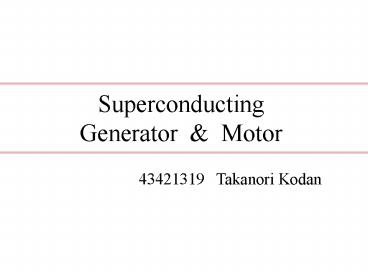Superconducting - PowerPoint PPT Presentation
1 / 15
Title: Superconducting
1
Superconducting Generator Motor
43421319 Takanori Kodan
2
Introduction
Superconductivity
Zero electrical resistance High critical
current density
Large current can be transmitted
High-temperature superconductor
Superconductivity can be cooled by liquid
nitrogen(77K)
Cooling cost is very low
Superconductivity is applied in various field
Example
Superconducting generator motor
3
Generator
Flemings right hand law
Motional energy?Electrical energy
evBl
eelectromotive force vvelocity Bmagnetic flux
density llength
Coil rotates at constant velocity
Electromotive force is induced
The electromotive force is alternate current
4
Commutator
Alternate current?Direct current
C1,C2commutator segment
B1,B2brush
The contact of commutator segment and brush is
replaced at p/2 rad
Current
B1?B2
Direct current can be gained
5
Motor
Flemings left hand law
Electrical energy?Motional energy
FiBl
Felectromagnetic force icurrent Bmagnetic flux
density llength
Generate the electrical current
Rotative force is generated by the
electromagnetic force
The contact of commutator segment and brush is
replaced at p/2 rad
The direction of the rotative force is constant
6
Superconducting Generator Motor
Superconductivity
Application
High transport current density
Electric propulsion ship
Large current can be transported
Superconducting generator motor
Downsize Weight save Large capacity
The carbon dioxide emissions can be reduced
7
Problem
There are some problems to be put to practical
use the superconducting generator motor
One of them is structual problem
Superconducting motor is generally cooled and
supplied electric power to the rotor
The structure is complicated
8
Development of a superconducting claw-pole motor
E. Watanabe a,, K. Kikukawa a, Y. Satoh b, S.
Torii b
a Central Japan Railway Company, 1545-33, Oyama,
Komaki-shi, Aichi 485-0801, Japan b Musashi
Institute of Technology, 1-28-1, Tamazutsumi,
Setagaya, Tokyo 158-8557, Japan
9
Introduction
Applying superconductivity to the rotating
machines
?
the smaller size, higher power,or efficiency is
realized
To applying
Rotate the field or rotate the armature
Each of which has structural problem to be rotated
Claw-pole motor
Only the iron core rotates while both of the
superconducting field coils and the armature
coils are fixed
Much advantage to simplify the structure of the
motors and the generators
10
Overview of the experimental machine
Axial-gap type claw-pole rotating machine
Superconductivity is applied to its two field
coils
When the current is applied to the
superconducting field coils, the eight
claw-poles, made of iron , are strongly
magnetized alternatively
The claw-poles are synchronously rotated by
applying the alternating current to the armature
coils and produce the rotating magnetic field.
Fig. 1. Overview of the experimental machine.
11
Overview of the experimental machine
The current is applied to the field coils
The magnetoresistance becomes large
The restoring magnetic force acts against the
rotors displacement along the axial direction
There is no thrust bearing in this machine
The spec of 500 mm diameter of the
superconducting field coils made of HTS wire
(Bi2223)
The rated magnetomotive force is 40 kA at the
rated operation temperature, 40 K
Fig. 2. The cross-sectional view of the machine.
12
Characteristics of the experimental machine as a
generator
the voltage and current waveforms
the torque
The 3.533O resistors are connected to every
output of three phases
The larger the magnetomotive force is,
the larger the torque is, too, but that seems to
be saturated around the rated current
the speed of 300 min-1
the phase of voltage wave is almost equal to
that of the current wave
Fig. 3. Voltage and current waves of generator.
Fig. 4. Torque of the generator.
13
Characteristics of the experimental machine as a
generator
The generated power
The relation between the generated power and the
armature current
It becomes larger and seems to be saturated as
the magnetomotive force is larger
The results of the experiments and the analyses
are not equal, but the general tendency seems to
be the same now
Fig. 5. Generated power.
Fig. 6. Load characteristic curve.
14
The thrust magnetic force and characteristics as
a generator
The relation between the thrust magnetic force
and the axial displacement of the rotor
Thrust magnetic force
There is not perfect linearity but enough
satisfying characteristic to act as a thrust
suspension mechanism within this displacement
Generated power
It is at the maximum without the displacement and
is getting smaller asthe larger displacement is
given, but the reduction remains to the small
extent of about 4
To produce the maximum generated power
Use it at the optimum point by arranging the
claw-poles based on the displacement with
someload in advance
the magnetomotive force40kA the external load
resistance3.533O the rotating speed300 min-1
Fig. 7. The thrust magnetic force and the
generated power
15
Summary
Designed and fabricated the experimental
superconducting claw-pole rotating machine and
made some experiments and analyses
The thrust magnetic force produced against the
rotors axial displacement had good
characteristic to act as a suspension mechanism
and the generated power did not greatly decrease
even if some axial displacement was provided





![[PPT] Superconducting Wire Market May See a Big Move PowerPoint PPT Presentation](https://s3.amazonaws.com/images.powershow.com/9904162.th0.jpg?_=20230706073)

























